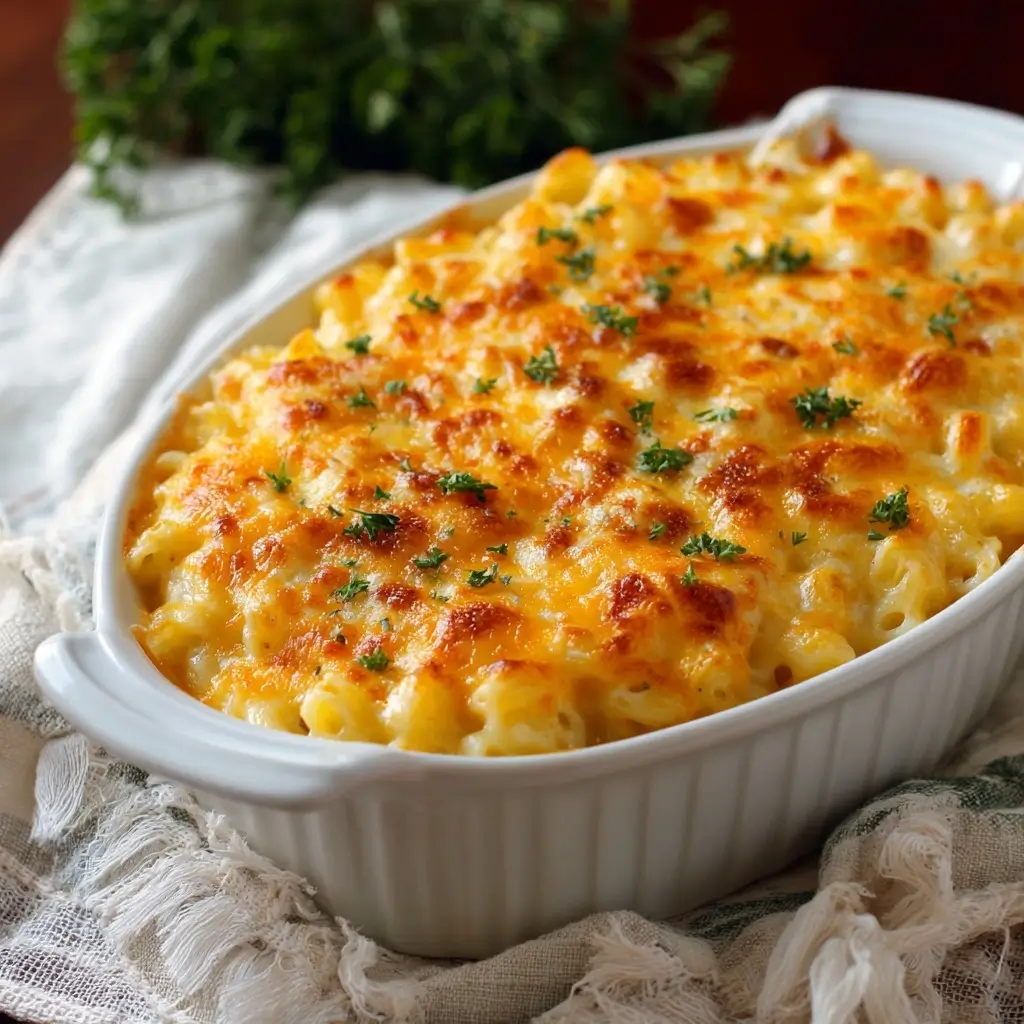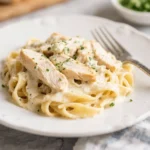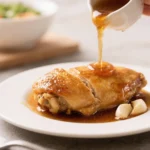Creamy Baked Mac & Cheese: The Ultimate Comfort Food Guide
The History of Mac & Cheese
Macaroni and cheese, affectionately known as “mac & cheese,” has a rich culinary history that spans centuries and continents. Its origins can be traced back to 13th-century Italy, where pasta dishes with cheese were already popular. One of the earliest recorded recipes resembling mac & cheese appears in De arte coquinaria per vermicelli e maccaroni siciliani, a medieval Italian cookbook by Maestro Martino, which describes boiled pasta served with grated cheese.
The dish crossed the Atlantic thanks to European settlers, particularly the British, who had their own version called “macaroni pie.” However, it was Thomas Jefferson who helped popularize mac & cheese in the United States. After encountering the dish during his time in France, Jefferson brought a macaroni machine back to America and served a version of mac & cheese at a state dinner in 1802. His recipe, adapted for American tastes, laid the foundation for what would become a beloved national comfort food.
By the 20th century, mac & cheese had become a staple in American households. The invention of boxed mac & cheese by Kraft Foods in 1937—initially priced at just 19 cents—made the dish accessible during the Great Depression and World War II. Today, while homemade versions have regained popularity, the legacy of convenience and comfort remains central to its appeal. Creamy baked mac & cheese stands as a modern evolution of this classic, combining rich, velvety cheese sauce with perfectly al dente pasta and a golden, crispy crust.
Ingredients Breakdown
To create the ultimate creamy baked mac & cheese, choosing high-quality ingredients is essential. Each component plays a vital role in achieving the perfect balance of flavor, texture, and richness.
- Elbow Macaroni: The classic choice due to its shape, which holds sauce beautifully. You can also use cavatappi, shells, or penne for added texture.
- Butter: Unsalted butter provides a rich base for the roux, allowing better control over salt levels. It contributes to both flavor and silkiness.
- All-Purpose Flour: Used to thicken the milk into a smooth roux-based sauce, preventing the cheese from becoming greasy or separating.
- Milk: Whole milk is recommended for creaminess, though half-and-half or heavy cream can be used for an even richer sauce.
- Dijon Mustard: A small amount enhances the cheese flavor without making the dish taste mustardy, adding depth and tang.
- Garlic Powder and Onion Powder: These add subtle savory notes that complement the cheese without overpowering it.
- Nutmeg: Just a pinch brings warmth and complexity, rounding out the overall flavor profile.
- Salt and Black Pepper: Essential for seasoning; freshly cracked pepper adds a nice bite.
- Sharp Cheddar Cheese: The star ingredient. Sharp cheddar melts well and offers a bold, tangy flavor. Aged cheddar works best for maximum flavor.
- Fontina Cheese: Known for its excellent meltability and mild nuttiness, fontina adds creaminess and helps create a gooey texture.
- Gruyère Cheese: Adds a sophisticated, slightly sweet and earthy note. It melts beautifully and enhances the sauce’s complexity.
- Parmesan Cheese: Grated fresh if possible, parmesan adds saltiness and umami, helping to deepen the overall cheesy profile.
- Breadcrumbs: Panko breadcrumbs are ideal for topping because they toast up light and crispy. Regular breadcrumbs work too.
- Olive Oil or Melted Butter (for topping): Tossing the breadcrumbs with oil or butter ensures they brown evenly and become delightfully crunchy.
Step-by-Step Recipe
- Preheat the Oven: Set your oven to 375°F (190°C). Lightly grease a 9×13-inch baking dish with butter or non-stick spray to prevent sticking.
- Cook the Pasta: Bring a large pot of salted water to a boil. Add 1 pound (16 oz) of elbow macaroni and cook according to package instructions until al dente—usually about 8–9 minutes. Drain and set aside. Do not rinse, as the starch helps the sauce cling to the pasta.
- Make the Roux: In a large saucepan or Dutch oven, melt 4 tablespoons (½ stick) of unsalted butter over medium heat. Stir in ¼ cup all-purpose flour and whisk constantly for 2–3 minutes until the mixture turns golden and smells nutty. This forms the base of your béchamel sauce.
- Add Milk Gradually: Slowly pour in 3 cups of whole milk, whisking continuously to avoid lumps. Continue cooking and stirring until the mixture thickens enough to coat the back of a spoon, about 5–7 minutes.
- Season the Sauce: Stir in 1 teaspoon Dijon mustard, ½ teaspoon garlic powder, ½ teaspoon onion powder, a pinch of ground nutmeg, 1 teaspoon salt, and ½ teaspoon black pepper. Mix well to combine.
- Melt the Cheeses: Reduce the heat to low. Gradually add 2 cups shredded sharp cheddar, 1 cup shredded fontina, 1 cup shredded Gruyère, and ½ cup grated Parmesan, one handful at a time, stirring until each addition is fully melted before adding the next. Avoid boiling the sauce once cheese is added, as high heat can cause separation.
- Combine Pasta and Cheese Sauce: Pour the cooked macaroni into the cheese sauce and stir gently until every noodle is evenly coated. Taste and adjust seasoning if needed.
- Transfer to Baking Dish: Pour the mac and cheese mixture into the prepared baking dish, spreading it out evenly.
- Prepare the Topping: In a small bowl, mix ½ cup panko breadcrumbs with 1 tablespoon olive oil or melted butter. Sprinkle the mixture evenly over the top of the mac and cheese.
- Bake Until Golden and Bubbly: Place the dish in the preheated oven and bake for 20–25 minutes, or until the top is golden brown and the edges are bubbling. For extra browning, switch the oven to broil for the last 1–2 minutes, watching closely to prevent burning.
- Rest Before Serving: Let the mac and cheese rest for 5–10 minutes after removing it from the oven. This allows the sauce to set slightly, making it easier to serve and ensuring a creamy texture.
Tips for Perfect Creamy Baked Mac & Cheese
- Shred Your Own Cheese: Pre-shredded cheese contains anti-caking agents that can make the sauce grainy. Shredding blocks of cheese yourself ensures a smooth, melty texture.
- Avoid Overcooking the Pasta: Since the mac and cheese will bake in the oven, undercook the pasta by 1 minute to prevent mushiness.
- Use Room Temperature Milk: Cold milk can shock the roux and cause lumps. Warming the milk slightly before adding helps achieve a smoother sauce.
- Whisk Constantly When Adding Milk: This prevents lumps from forming in the béchamel sauce.
- Low Heat for Melting Cheese: High heat can break the emulsion, causing the sauce to become oily. Always melt cheese over low heat and stir gently.
- Let It Rest After Baking: Allowing the dish to sit briefly helps the sauce absorb into the pasta and improves sliceability.
- Double the Recipe for a Crowd: This dish scales well. Use a larger baking dish (like 9x13x2 inches) and increase baking time slightly.
- Freeze for Later: Assemble the mac and cheese (without baking), cover tightly, and freeze for up to 3 months. Thaw overnight in the fridge and bake as directed, adding 10–15 minutes if still cold.
Variations and Customizations
Creamy baked mac & cheese is incredibly versatile. Here are some delicious ways to customize it:
- Bacon Mac & Cheese: Stir in 1 cup of crispy cooked bacon pieces before baking. Top with extra bacon for a smoky crunch.
- Lobster Mac & Cheese: Fold in 1–2 cups of cooked lobster meat for a luxurious twist. Perfect for special occasions.
- Truffle Mac & Cheese: Drizzle with truffle oil or add a spoonful of truffle paste to the sauce for an earthy, gourmet flavor.
- Spicy Jalapeño Popper Mac: Mix in diced pickled jalapeños and cream cheese. Top with crushed Ritz crackers mixed with cheddar.
- Veggie-Packed Mac: Add steamed broccoli, sautéed mushrooms, roasted red peppers, or spinach for a healthier boost.
- Buffalo Chicken Mac & Cheese: Combine shredded rotisserie chicken tossed in buffalo sauce with blue cheese crumbles swirled into the cheese sauce.
- BBQ Pulled Pork Mac: Layer in tender pulled pork and a hint of BBQ sauce for a Southern-inspired treat.
- Gluten-Free Version: Use gluten-free pasta and substitute the all-purpose flour with cornstarch or a gluten-free flour blend.
- Dairy-Free/Vegan Option: Use plant-based butter, unsweetened almond or oat milk, and vegan cheeses made from cashews or coconut. Nutritional yeast adds a cheesy flavor.
- Extra Crispy Topping: Swap panko for crushed potato chips, French fried onions, or buttery cracker crumbs like Ritz or Saltines.
Health Considerations and Nutritional Value
Creamy baked mac & cheese is undeniably indulgent, but understanding its nutritional content can help you enjoy it mindfully.
Nutritional Profile (Per Serving, Approx. 1/6 of Recipe):
- Calories: ~450–550 kcal
- Fat: 25–35g (saturated fat: 15–20g)
- Carbohydrates: 40–50g
- Protein: 18–22g
- Sodium: 600–900mg (depending on cheese and seasoning)
- Calcium: ~30% of Daily Value (DV)
- Vitamin A and B12: Significant amounts from dairy
Health Tips:
- Portion Control: Serve smaller portions alongside a green salad or roasted vegetables to balance the meal.
- Lighter Version: Use reduced-fat cheese, low-fat milk, and less butter. Replace half the pasta with cauliflower florets for a lower-carb option.
- Add Fiber: Choose whole wheat or legume-based pasta to increase fiber and protein content.
- Reduce Sodium: Opt for low-sodium cheese and broth-infused milk instead of salt-heavy seasonings.
- Omega-3 Boost: Stir in flaxseed or chia seeds (though subtle in flavor, they add nutrients).
While traditional mac & cheese is high in saturated fat and calories, enjoying it occasionally as part of a balanced diet is perfectly fine. The key is moderation and smart substitutions when desired.
Ingredients
- 1 pound (16 oz) elbow macaroni
- 4 tablespoons unsalted butter
- ¼ cup all-purpose flour
- 3 cups whole milk
- 1 teaspoon Dijon mustard
- ½ teaspoon garlic powder
- ½ teaspoon onion powder
- Pinch of ground nutmeg
- 1 teaspoon salt
- ½ teaspoon black pepper
- 2 cups shredded sharp cheddar cheese
- 1 cup shredded fontina cheese
- 1 cup shredded Gruyère cheese
- ½ cup grated Parmesan cheese
- ½ cup panko breadcrumbs
- 1 tablespoon olive oil or melted butter (for topping)
Directions
- Preheat oven to 375°F (190°C). Grease a 9×13-inch baking dish.
- Boil pasta in salted water until al dente. Drain and set aside.
- In a large saucepan, melt butter over medium heat. Whisk in flour and cook for 2–3 minutes to form a roux.
- Gradually whisk in milk until smooth and thickened (5–7 minutes).
- Stir in Dijon mustard, garlic powder, onion powder, nutmeg, salt, and pepper.
- Reduce heat to low. Add cheeses one handful at a time, stirring until melted and smooth.
- Add cooked pasta and stir until fully coated.
- Transfer to baking dish. Top with breadcrumb mixture.
- Bake for 20–25 minutes until bubbly and golden. Optional: broil 1–2 minutes for extra crispness.
- Let rest 5–10 minutes before serving.
FAQ
Can I make mac and cheese ahead of time?
Yes! Assemble the dish up to 24 hours in advance and refrigerate. Bake as directed, adding 5–10 minutes to the cooking time. You can also freeze it before or after baking.
Why is my mac and cheese grainy?
This usually happens when the cheese is overheated or low-quality pre-shredded cheese is used. Always melt cheese over low heat and shred your own blocks.
Can I reheat baked mac and cheese?
Absolutely. Reheat in the oven at 350°F (covered with foil) for 20–25 minutes, or microwave individual portions with a splash of milk to restore creaminess.
What kind of pan should I use?
A 9×13-inch ceramic or glass baking dish works best. Metal pans may cook faster and brown more quickly.
Can I add eggs to make it creamier?
Some recipes include beaten eggs in the cheese sauce to enrich and stabilize it, especially for make-ahead versions. Try adding 1 egg yolk for extra silkiness.
How do I store leftovers?
Store cooled mac and cheese in an airtight container in the refrigerator for up to 4 days. Freeze for up to 3 months.
Summary
Creamy baked mac & cheese combines perfectly cooked pasta with a luxuriously smooth, multi-cheese sauce and a golden, crispy topping for the ultimate comfort food experience.
Whether enjoyed classic or customized with gourmet add-ins, this timeless dish brings warmth, nostalgia, and undeniable indulgence to any table.










